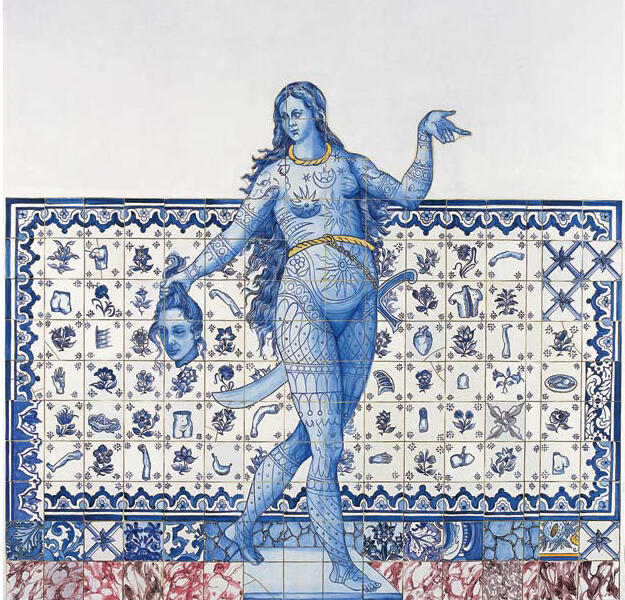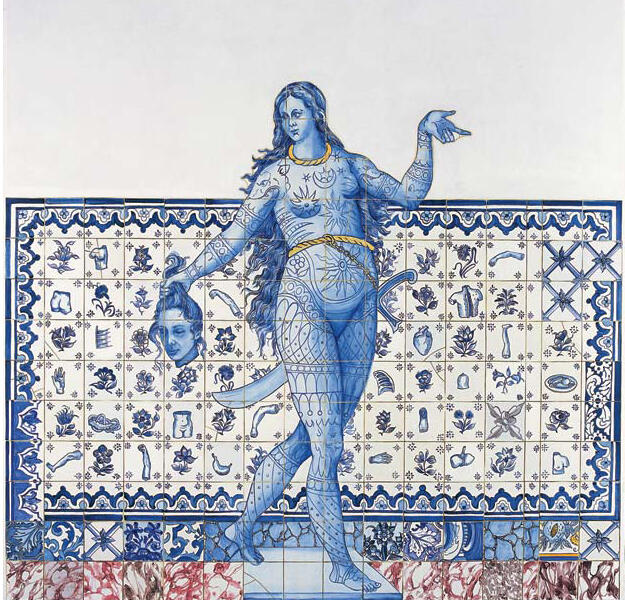Adriana Varejão´s retrospective: “Histórias às Margens” at MAM, São Paulo, Brazil
The Museum of Modern Art, São Paulo, Brazil, is presenting a retrospective of Adriana Varejão, one of the most renowned artist of her generation, from 4 September through 16 December 2012.

“Histories at the Margins” presents works that have never before been exhibited in Brazil, on loan from renowned collections including Fundació “La Caixa” (Barcelona), Solomon R. Guggenheim (New York), and Tate Modern (London), which is lending Azulejaria Verde em Carne Viva (2000). A major work entitled Parede com Incisões à la Fontana (2000), created as a direct engagement with and response to the work of Lucio Fontana, is also on view. Both paintings mentioned above illustrate an important theme in Varejão’s art; they interact uniquely with the Baroque legacy of Minas Gerais, the barroco mineiro. Varejão developed a fertile dialogue with the style when she was first introduced to baroque masters such as Aleijadinho during a trip to Ouro Preto (Minas Gerais) early in her career, in 1986. Adriana Varejão’s Rio de Janeiro-based production is particularly rich in historical and artistic references. One such example on view in the exhibition is “Reflexo de sonhos no sonho de outro espelho” (Estudo sobre o Tiradentes de Pedro Américo), from 1998, arguably one of her most expressive works. The installation, composed of 21 paintings, is a re-reading of Pedro Américo’s (1843-1905) iconic “Tiradentes Esquartejado”. Varejão created the work for the São Paulo Bienal in 1998, curated by Paulo Herkenhoff and considered to be one of the country’s most successful biennials. Curated by Adriano Pedrosa, Varejão’s long-time collaborator, Histórias às Margens , (Histories at the Margins) features 42 works created over two decades, including early paintings such as Milagre dos Peixes (1991) as well as newly created works for the exhibition, among them a large-scale polyptych composed of 54 panels entitled “Carnívoras”.
Histories at the Margins evokes, in its Portuguese title (Histórias às Margens), not only historical traditions but stories, as Pedrosa defines it, “the marginal histories and stories often forgotten or relegated to the margins by historic tradition, irrespective of whether they refer to Brazil, Portugal, China, art itself, the Baroque, colonization. Varejão researches these histories, rescues and interweaves them in her paintings.” Many of the paintings Varejão has created especially for this exhibition are significant examples of such interweaving. For instance, a large-scale painting of Guanabara Bay rendered in a style that recalls Chinese antiquities echoes back to a series Varejão began in 1992, when, impressed by the influence that Chinese art exerted over the Brazilian baroque, she spent three months in China. Varejão found inspiration in Song Dynasty ceramics and developed an interest in craquelature. The effect is present in many of her works and is quite noticeable in the exhibition’s largest painting, the new “Carnívoras”, composed of 54 panels, each measuring one square meter.
Carnivorous plants from various places around the world are painted in red over canvases with surfaces that allude to the texture of Azulejo tile art. This polyptych is Varejão´s return to the poetics of a work conceived for the 2003 MAM-SP Panorama of Brazilian Art, in which she created larger-than-life tiles decorated with hallucinogenic plants. These ceramic tile creations can be seen currently, along with other works by Varejão, in a permanent pavilion dedicated to her work at the Inhotim Contemporary Art Institute, at Brumadinho, Minas Gerais. The visual concept of Histories at the Margins was conceived by architect and designer Rodrigo Cerviño Lopez, who was responsible for designing the pavilion at Inhotim and Varejão’s studio in Rio de Janeiro.
September 4 to December 16, 2012
Museu de Arte Moderna, São Paulo
Parque do Ibirapuera, portão 3
São Paulo, Brazil
-
 Entrance Figure III, 2005. Oil on canvas, 200 x 200cm. Collection Adriana Varejão, Rio de Janeiro. Courtesy the artist, Lehmann Maupin Gallery, New York and MAM, São Paulo.
Entrance Figure III, 2005. Oil on canvas, 200 x 200cm. Collection Adriana Varejão, Rio de Janeiro. Courtesy the artist, Lehmann Maupin Gallery, New York and MAM, São Paulo.




